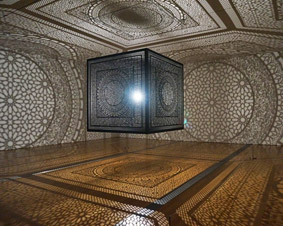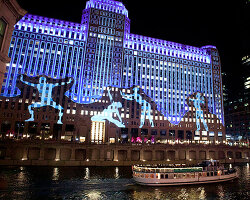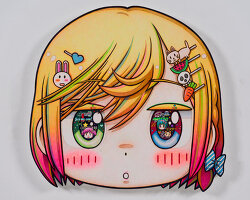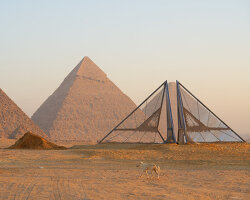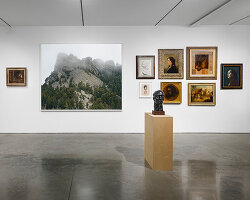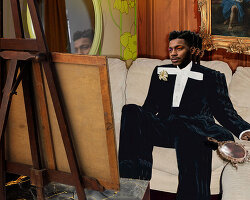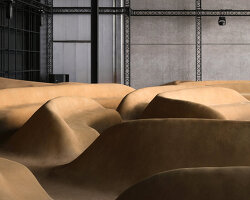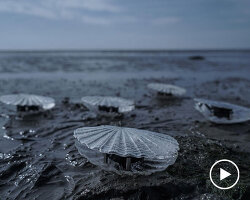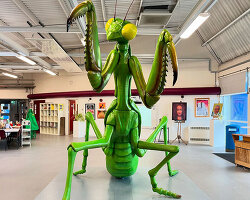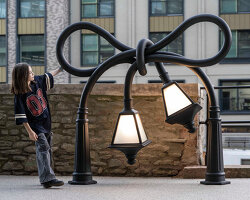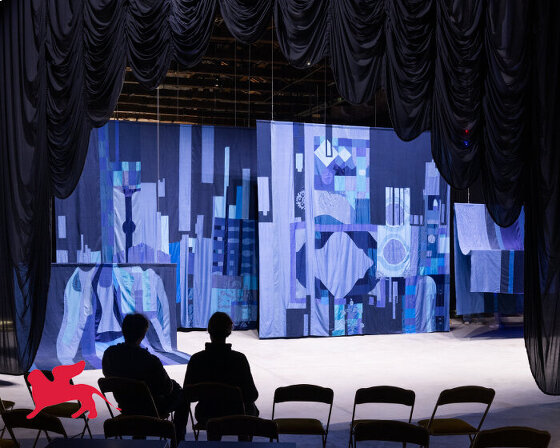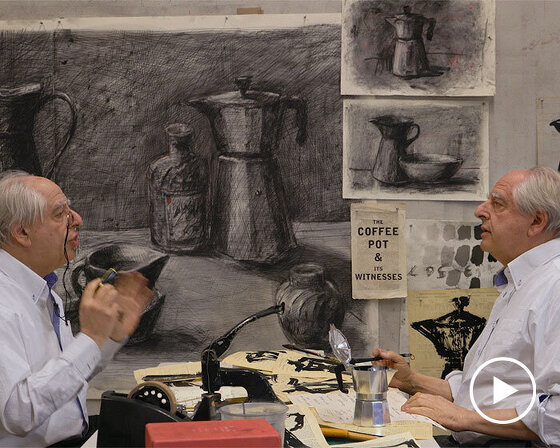born and raised in lahore, pakistan, before later moving to the united states, artist anila quayyum agha has been deeply influenced by the simultaneous sense of alienation and transience that informs the migrant experience. ‘my experiences in my native pakistan and as an immigrant here in the united states are woven into creating artwork that participates in re-defining and re-writing women’s or immigrants’ handiwork as a poignant and often excluded form of creative expression,’ she shares in a poignant and powerful interview with designboom. from installations monumental in scale to intimate embroidered drawings, agha’s work explores the entwined yet contradictory relationships between gender, culture, religion, labor and social codes. ‘the use of a variety of media, to create large-scale sculptural installations or intimate embroidered drawings to question my place within these binaries, allows me to inquire into the validity of our broad cultural acceptance of them,’ she shares.
treating light as a sculptural material, the artist’s work has stunned viewers with its complex, interlacing ornamentation and spectacular interplay of light and shadow — a theme drawn from her familiarity with the architectural legacy of the islamic mughal dynasty in south asia and its intricate carved marble screens, or jaalis. hidden shapes and patterns emerge from fractured shadows in dramatic displays across walls that induce a state of contemplation and introspection. ‘mixing reflections and shadows with solid forms and often transposing the resulting effect, my artwork aspires simultaneously to be perceptually soothing and conceptually challenging. all my past experiences coalesced, allowing me to explore and combine pattern, light, and shadow as materials within my art practice.’
in an in-depth interview, anila quayyum agha paints a powerful picture of how life in both pakistan and the united states has profoundly shaped her artistic identity.
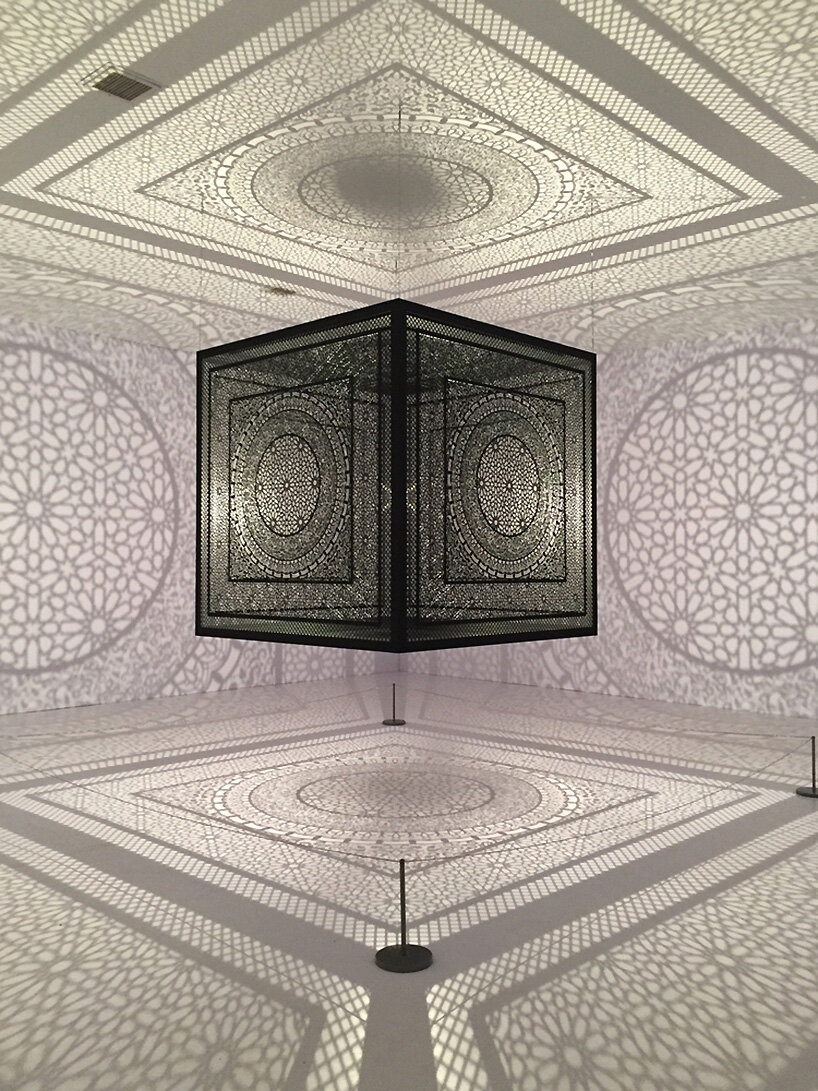
intersections | artprize: grand rapids art museum: grand rapids, MI 2015
lacquered wood and halogen bulb | 78″ x 78″ x 78″, cast shadows: 43.5′ x 43.5′ x 16′
designboom (DB): what aspects of your background and upbringing have shaped your creative principles and philosophies?
anila quayyum agha (AQA): I was born and raised in lahore, pakistan during rather turbulent political times in the country’s history. at age five, I was sent to boarding school run by british-expats in murree (a hill town), where amongst other things I learnt english, an excellent skill to have in post-colonial pakistan. after my father’s passing, I started working from age 16 to pay for college and contribute in taking care of my immediate family. I often felt sad for my mother who had dreamt of being an interior designer but was married straight out of high school, which made me realize the significance of higher education.
during my undergraduate studies at the national college of art (NCA) in lahore, pakistan, I held many jobs to pay for college, including modeling assignments for television and newspapers. the experiences at work and as a model made me realize that pakistani culture largely viewed women as either sex objects or mothers, and considered the female body fair game for harassment or ownership. in those early days, I dealt with economic challenges exasperated by abysmal pay which, coupled with both physical and mental harassment at work and in public, can be termed as some of my most important formative experiences that fueled my artistic persona.
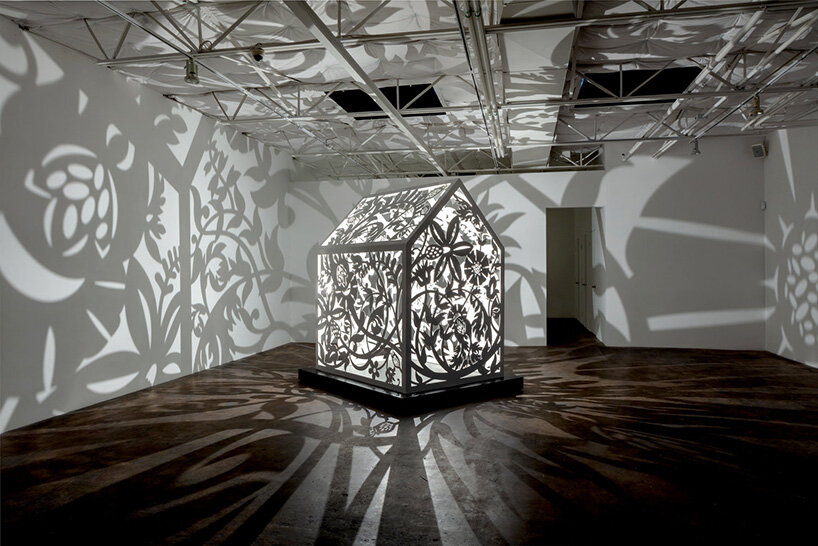
this is NOT a refuge! 2 | installation at talley dunn gallery, dallas, TX, 2019
laser-cut, resin coated aluminum, light bulb | H 93” x W 58” x D 72”
photo by kevin todora, courtesy of talley dunn art gallery, dallas, TX
AQA (continued): in art school, many women professors influenced me. notably, professor salima hashmi, an artist and curator, and later the principal of NCA, along with the inimitable activist, professor and artist, lala rukh, were big influences. lala rukh among others, organized protest marches and started the women’s action forum in pakistan. the marches were organized to protest the hudood ordinance, signed into law by martial-law dictator zia ul haque. this offensive law equated a woman’s testimony to a ¼ of a man’s testimony in her own defense in a rape case, unless four women gave witness to the alleged rape. the rape victims were imprisoned anyway, as the punishment for adultery was jail time. since most rapes happen in secret, it largely kept the female population mute and oppressed. a key element to my intellectual growth was my attendance at these marches protesting the inequity between genders during my early college years. it seemed to me the patriarchy had permission to rape, murder and honor-kill women with impunity. at the time, I remember simultaneously feeling empowered and powerless, which made me determined to create my own life independent of cultural pressures.
that realization helped foment my emerging identity, while art college aided the development of aesthetic skills, work-ethic and discipline. the lessons learned in pakistan, accompanied by gender inequities in united states created determination and an abiding desire to disseminate my ideas as an artist despite tremendous challenges. as a naturalized US citizen, I have chosen to live in the US. my decision to immigrate was not made lightly. I think the loss of family, friends, the familiarity of home and culture is a traumatic experience that continues to live quietly in the background. the adversity experienced over the decades has given me a clear sense of self-worth, making my life richer and full of possibilities. having said that, I continue to live in an in-between place that often makes me an outsider both in pakistan and the US.
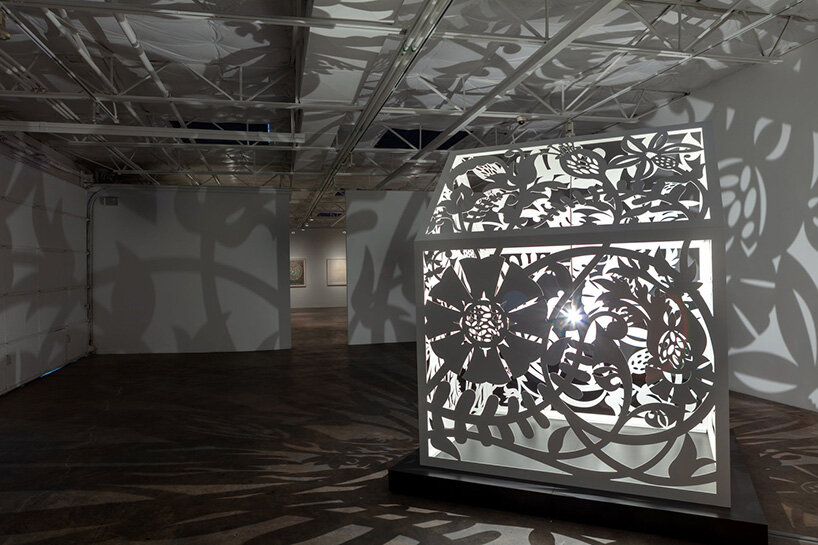
this is NOT a refuge! 2 | installation at talley dunn gallery, dallas, TX, 2019
laser-cut, resin coated aluminum, light bulb | H 93” x W 58” x D 72”
photo by kevin todora, courtesy of talley dunn art gallery, dallas, TX
DB: what draws you to treating light as a sculptural material? can you talk about the idea of giving form to light?
AQA: combining light and shadow as a medium in my art practice happened over time due to myriad experiences at different points in my life, both in the east and the west. incorporating light wasn’t a novel idea for me due to my love of and familiarity to the carved marble screens (jaalis) — an architectural legacy of the islamic mughal dynasty in south asia. the sun’s cycle simultaneously cast mobile shadows and enabled fresh air to filter through the ancient buildings to alleviate the oppressive heat and brightness of the region, whilst also supplementing the beautifully patterned, carved and tiled environs. the additional layer to my developing aesthetic was the added observation of old and new ideas being integrated into modern pakistani architecture such as jaalis and tiles. another subsequent experience was a trip to venice, italy in my early twenties. in a back alley, I found a few glass blowing artists making animal figurines. I was fascinated by the intricate process so adeptly used and watched the artists at work for a long time, loving the light filtering through the precious, colored blown glass animals. on my return from europe, I completed my BFA in lahore, occasionally thinking of the blown glass process. a few years later in the united states, I dealt with my sense of transience and displacement through recollections of lahore. in my mind’s eye, beloved faces of family and friends became closely entwined with lahore and its spaciousness, warmth and bright sunlight filtering through the canopy of trees.
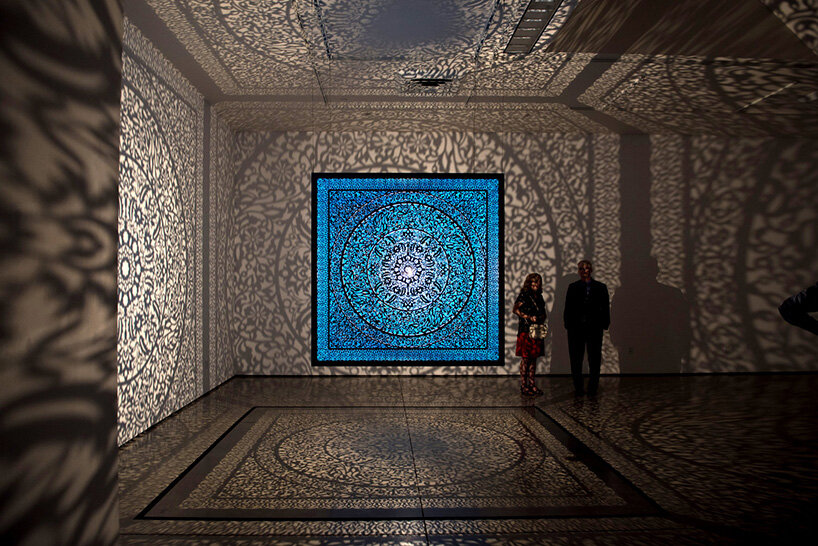
all the flowers are for me – turquoise, 2017 | the harold j miossi art gallery, cuesta college, san luis obispo, CA
lacquered steel and halogen bulb | 60″ x 60″ x 60″
photo courtesy of cuesta college, san luis obispo CA
AQA (continued): in graduate school around the same time, I was making drawings by using pattern, dyes, embroidery, encaustic wax and cut-outs on paper to imitate the filtration of light and shadow of my memories. my early work was abstractly inspired by architecture, and the disorder within order I had encountered in pakistan. on graduating with an MFA from university of north texas, I moved to houston for an artist residency, where I experienced two artworks that further influenced me. the first was the fluorescent light installation by artist dan flavin who revolutionized artmaking in the sixties by introducing fluorescent tubes as a sculptural medium, and was later commissioned to create a site-specific installation at richmond hall located at the menil campus. also in houston, I often visited the MFAH, where I’d see cornelia parker’s poignant light installation made from remnants of an exploded shed and lit with a single light bulb. these viewing experiences allowed me to ruminate. moving to indianapolis as an assistant professor at herron school of art and design/IUPUI, then enabled me to visit the indianapolis museum of art (newfields) to view robert irwin’s disc composed of an object, light and space. I was by then able to travel internationally and experienced both the contemporary weather project by olafur eliasson at the tate modern in london and the medieval alhambra palace complex in southern spain. these two distinct experiences, coupled with earlier memories of contemporary artworks and the ancient mughal jaalis, provided me with the impetus to explore my own ideas of light, while additionally teaming it with my love of ‘pattern’ to build my first large-scale cube. I now think that moment in time was ripe for me, as all my past experiences coalesced allowing me to explore and combine pattern, light/shadow as materials within my art practice.
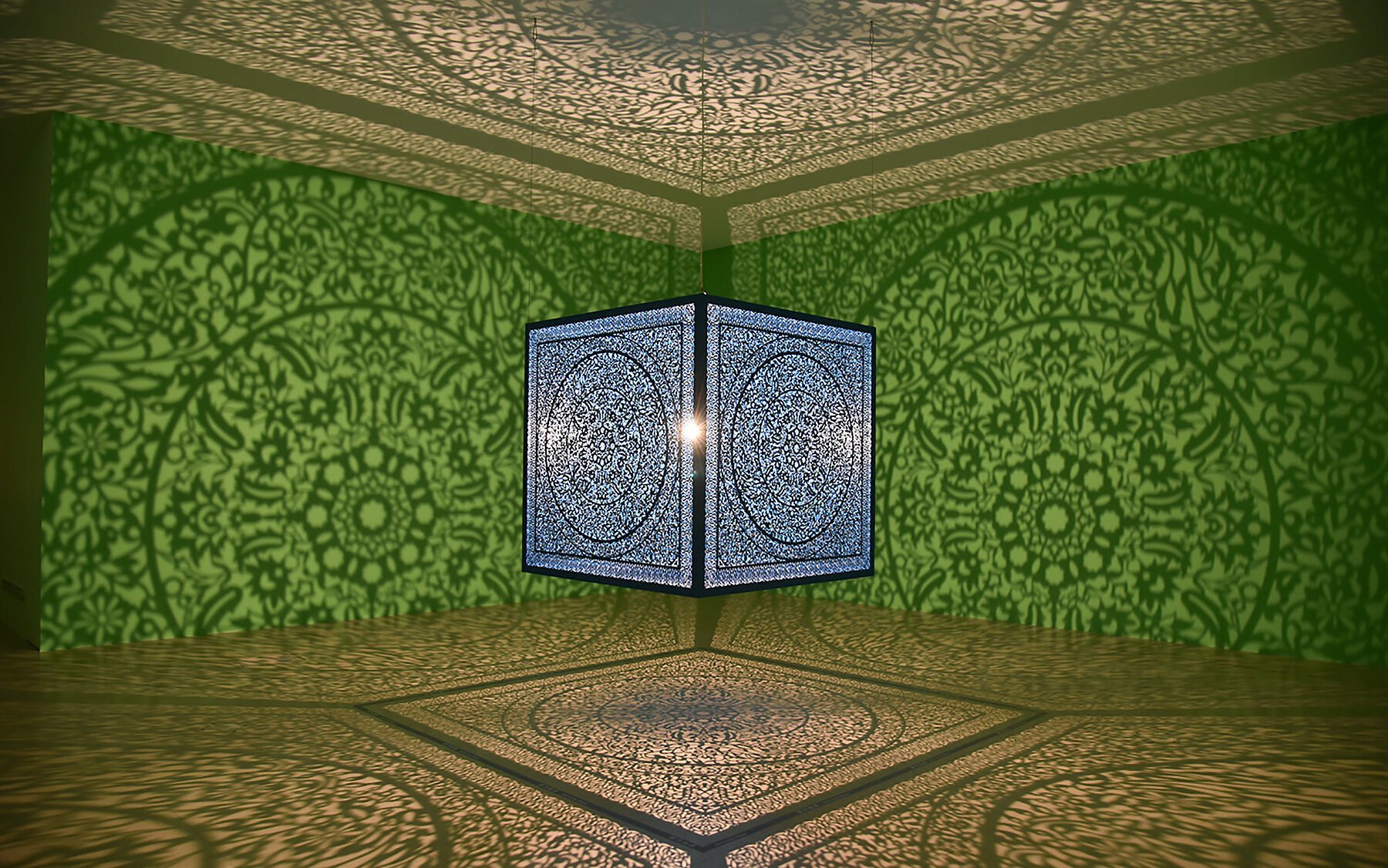
all the flowers are for me – turquoise | chimei museum, tainan city, taiwan, 2019 | lacquered steel and halogen bulb | 60″ x 60″ x 60″
photo courtesy of chimei museum
AQA: I think my artwork is deeply influenced by the simultaneous sense of alienation and transience that informs the migrant experience. this consciousness of knowing what is markedly different about the human experience also bears the gift of knowing its core commonalities, and it is these tensions and contradictions that I try to embody in my artwork. through the use of a variety of media, from large sculptural installations to embroidered drawings, I explore the deeply entwined yet contradictory political relationships between gender, culture, religion, labor and social codes. over time, I have used combinations of textile and sculptural methodologies to reveal and question the gendering of textile/ craft work as inherently domesticated and excluded from being considered a fine art form. my experiences in my native pakistan and as an immigrant here in the united states are woven into creating artwork that participates in re-defining and re-writing women’s or immigrants’ handiwork as a poignant and often excluded form of creative expression.
I gravitated to embroidery from my first year at graduate school; obsessively stitching on my fiber and painting surfaces before applying paint or dyes. the sewing referenced memories of sewing circles my mother organized annually with women in our neighborhood. these women would gather in our backyard to unpick the previous year’s quilts, re-fluff the cottonwool and then re-stitch a single quilt in a circle. being very young, I played under the quilt pulled taut on the laps of several women during the morning ritual. I’d listen to the women talk about their lives, touching upon husbands, children, education or lack thereof, limited opportunities with menial jobs, and no healthcare. occasionally they would discuss domestic violence, but shushed when they realized I was eavesdropping. I found it very interesting and listened until boredom, imagination or sleep took over.
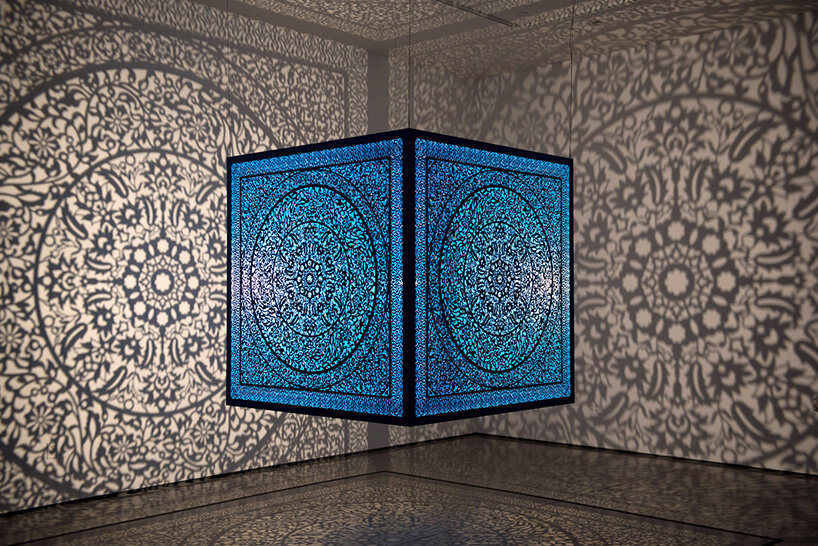
all the flowers are for me – turquoise, 2017 | the harold j miossi art gallery, cuesta college, san luis obispo, CA
lacquered steel and halogen bulb | 60″ x 60″ x 60″
photo courtesy of cuesta college, san luis obispo CA
AQA (continued): during my early fledgling career in the USA, criticism from my peers and faculty often focused on my artwork being too beautiful or well-crafted and was encouraged to add tension and dichotomy. I learnt to add contradictions in my own way without forsaking my culture, which I think helped me tremendously as I refrained from trying to be something I wasn’t. I began experimenting with cutting into the paper surface and then sewing the cut edges with buttonhole stitches. intuitively, I think I was trying to create healing spaces within the artwork. by then, I had also discovered my love of pattern and gravitated towards chaos contained within order.
after graduating from UNT, I made a series of drawings fashioned with geometrical patterning, cutouts and stitchwork. using fiber techniques like wax and fabric dyes on paper, I created translucent and opaque areas within a single drawing. I’d cut shapes into the paper, then insert dyed/painted waxed paper in the cut-out areas to then bind the two together with stitchwork, and titled the series illuminated inner spaces 1-8. the use of embroidery for the inserts and the edges of the empty holes on paper allowed me to create sculptural spaces within the picture plane permitting light to filter in. the raised relief stitchwork and the cutouts added depth with the cast shadows, which incidentally was also the time I earnestly started working with shadows. it seemed to me that my audience appreciated the experience of intimacy, delicacy and belonging my artwork provided and which I had longed for, for myself.
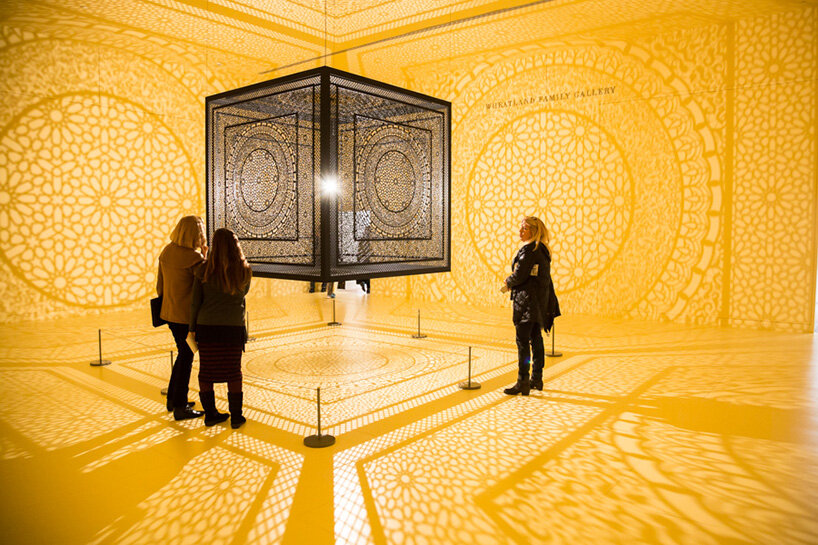
intersections | peabody essex museum: salem, MA 2016
lacquered steel and halogen bulb | 78″ x 78″ x 78″, cast shadows: 43.5′ x 43.5′ x 16′
image © 2016 peabody essex museum; photo by kathy tarantola
DB: through your work, how do you seek to express the experience of alienation and isolation for people who are marginalized and oppressed?
AQA: within my art practice, exploring the perceived cultural and social polarities, such as the masculine-feminine, public-private, definite-amorphous, and religious-secular, permits me to delve into controversial topics that reflect upon topical themes of cultural identity, global politics, mass media and social/gender roles. experiences of loss and shifting identities inform my artwork, allowing me to explore social and gender-based issues within our contemporary societies. the use of a variety of media, to create large-scale sculptural installations or intimate embroidered drawings to question my place within these binaries allows me to inquire into the validity of our broad cultural acceptance of them. mixing reflections and shadows with solid forms and often transposing the resulting affect, my artwork aspires simultaneously to be perceptually soothing and conceptually challenging. to clarify, my work is not about religions, but a contemplation on the nature of boundaries and alienation, and on the power of dialogue to transcend the barriers of gender, race, religion, and culture that prevent the true intersections and exchanges between cultures.
the pendulum across the world swings right vs. left every so often. with the recent racist rhetoric of the trump presidency, the pendulum seems to have swung far right, and nationalistic fervor has taken root in the united states, europe and parts of asia and south america. tremendous upheaval in the political discourse is further exasperated by intolerant religious doctrine coupled with inaccurate reporting from opinion media outlets such as fox news. the result seems to be that diverse groups of people are again marginalized based on race and gender, resulting in mass shootings and hate crimes targeting ‘others’ i.e., black, brown, asian and queer people; and similar to the rhetoric I encountered on my arrival to the united states in november 1999.
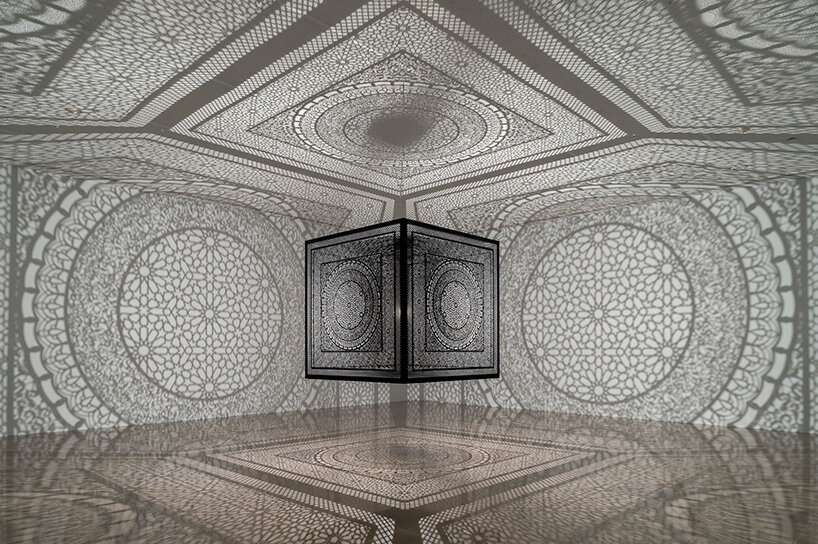
intersections | presented at rice gallery in houston, texas from september 24 – december 6, 2015
image by nash baker, courtesy of rice gallery
AQA (continued): my arrival occurred a year prior to the 9/11 terrorist attacks. being visually and oratorically immigrants from south asia and living in dallas, texas inevitably resulted in overwhelming problems of displacement and discrimination. the aftermath of the september 11th attack in the USA accentuated the hatred towards immigrants and made me acutely aware of the lack of support of family or friends. having enrolled in the MFA program at the university of north texas by then, I poured all my angst into my artwork and was tremendously grateful that advanced academic institutions in the USA don’t allow hateful acts or speech. my seven-year-old son was not so lucky, as young children mimic their families’ racist rhetoric, which at the time targeted south asian immigrants. rafae, my son, was frequently bullied by his classmates with the name rafae bin laden and a few of his teachers didn’t seem very enlightened either. I found it difficult to build deep friendships with people while in college. I still think, the distrust towards ‘others’ hasn’t abated over the decades, although scapegoats keep changing and currently it’s east asians being targeted. I often think, surely politicians are the only beneficiaries of such racial tensions as keeping the racist rhetoric alive ensures they win coveted governmental positions fanned by the fear of the ‘other’. I occasionally wonder if people in the USA (often religiously devout people) think critically about their intense hatred and fear of darker skin color especially when the assignation of color, race, or gender is not in the human domain. having faced discrimination both in pakistan as a woman and as an immigrant here in the USA, I work hard to deal with these potent issues in my work.
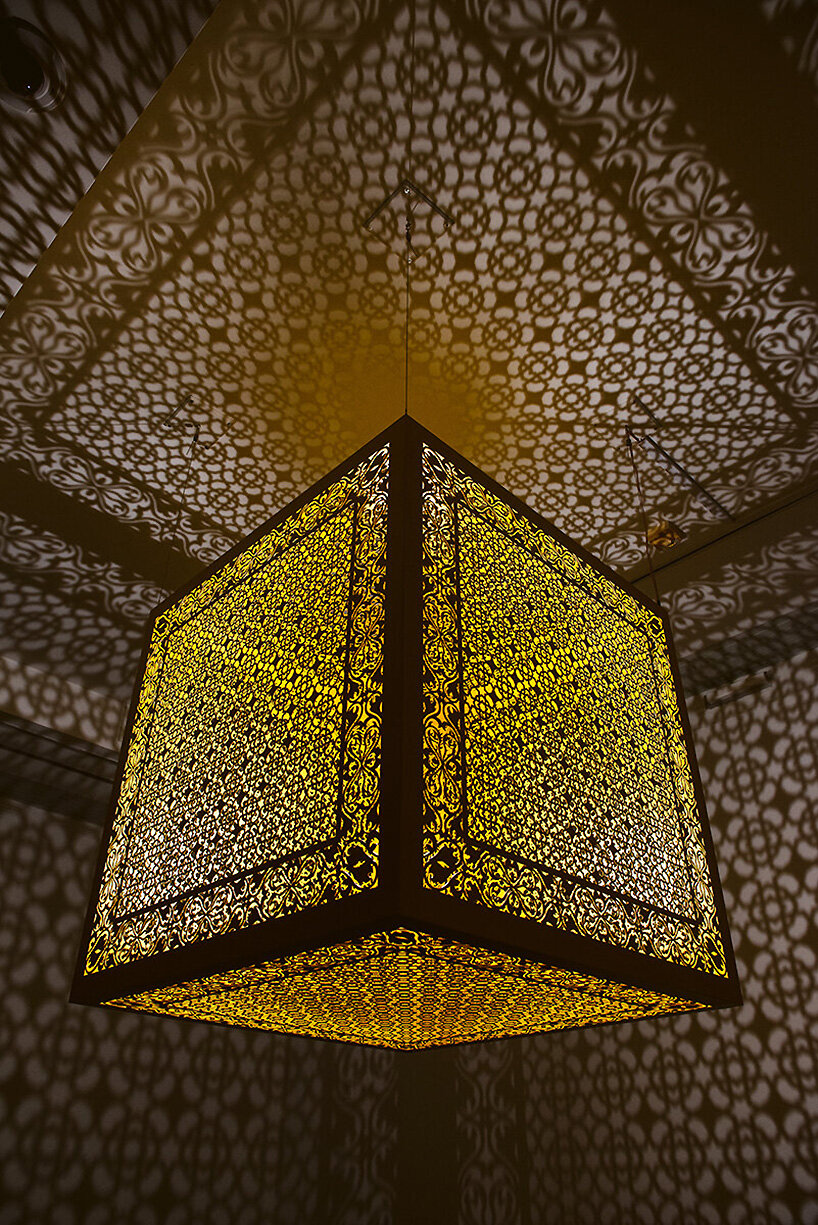
hidden diamond: yellow, 2019 | transcendent: spirituality in contemporary art, BCA center, burlington, VT
lacquered steel and halogen bulb | 36″ x 36″ x 36″
photo by sam simon
DB: what tensions or contradictions does your artwork embody?
AQA: the complicated social issues inherent in the fiber field have continued to inspire my usage of textile processes, such as embroidery and pattern, invoking for me the history and residual memory of feminine domesticity. the use of embroidery in the drawings both connects the multiple layers that result from my exploration of the interaction of concept and process, and bridge the gap between modern materials and the historical patterns of oppression or domestic servitude. the seductive and layered surfaces may suggest a deeper exploration of issues of submission, oppression and domesticity resulting in artwork that is conceptually ambiguous, producing complicated weaves of thought, artistic action and social experience. simultaneously, I also want to aid the viewers in observing the painstakingly evident craft which is habitually devalued, to reflect on society’s gendered definitions and to participate in reshaping those definitions.
to elaborate, I start with familiar islamic motifs/ patterns, that in due course become re-interpretations of the original designs, allowing me to infuse a contemplative focus suggestive of the underlying order of both the cosmos and the natural world through symmetries found in nature. these familiar islamic geometric motifs, due to their reproductions in public environments, allow me to excavate and re-interpret these motifs from the everyday and elevate them to the extraordinary to reveal the complexities of symbiosis between genders, cultures and civilizations and the amorphous borders between them all. within my work, the viewer is invited to confront the contradictory nature of all intersections, while simultaneously exploring boundaries such as the interplay of presumed opposites like male and female, the definite or the amorphous, the geometric and the organic. I work with materials that seem ethereal, inhabiting a space between visibility and invisibility, reality and unreality, light and shadow, real and unreal. these materials appear fragile, but are often resilient and hardy. often, my goal is to explore the binaries of public and private, light and shadow, and static and dynamic by relying on the purity and inner symmetry of geometric design, and the interpretation of the cast shadows. the audience’s presence is essential in experiencing a shared space while simultaneously affording intimacy, suggestive of the fluidity of human interactions. the exaggerated or fragmented shadows cast in all directions by the light spilling through the sculpture’s cutout surfaces work magically, creating a sublime yet dynamic transformation in tandem with the itinerant movement of the audience. my artwork portrays my interest in contradictions within materials and process like heavy steel cut with lace-like patterns to reflect and refract light, representing spaces of belonging, evaluations of race and culture, gender and creed and the cycles of life and death. the conceptual ambiguity of the resulting patterns in the artwork, create an interactive experience in which the onlooker’s subjective experiences of alienation and belonging become part of the piece and its identity.
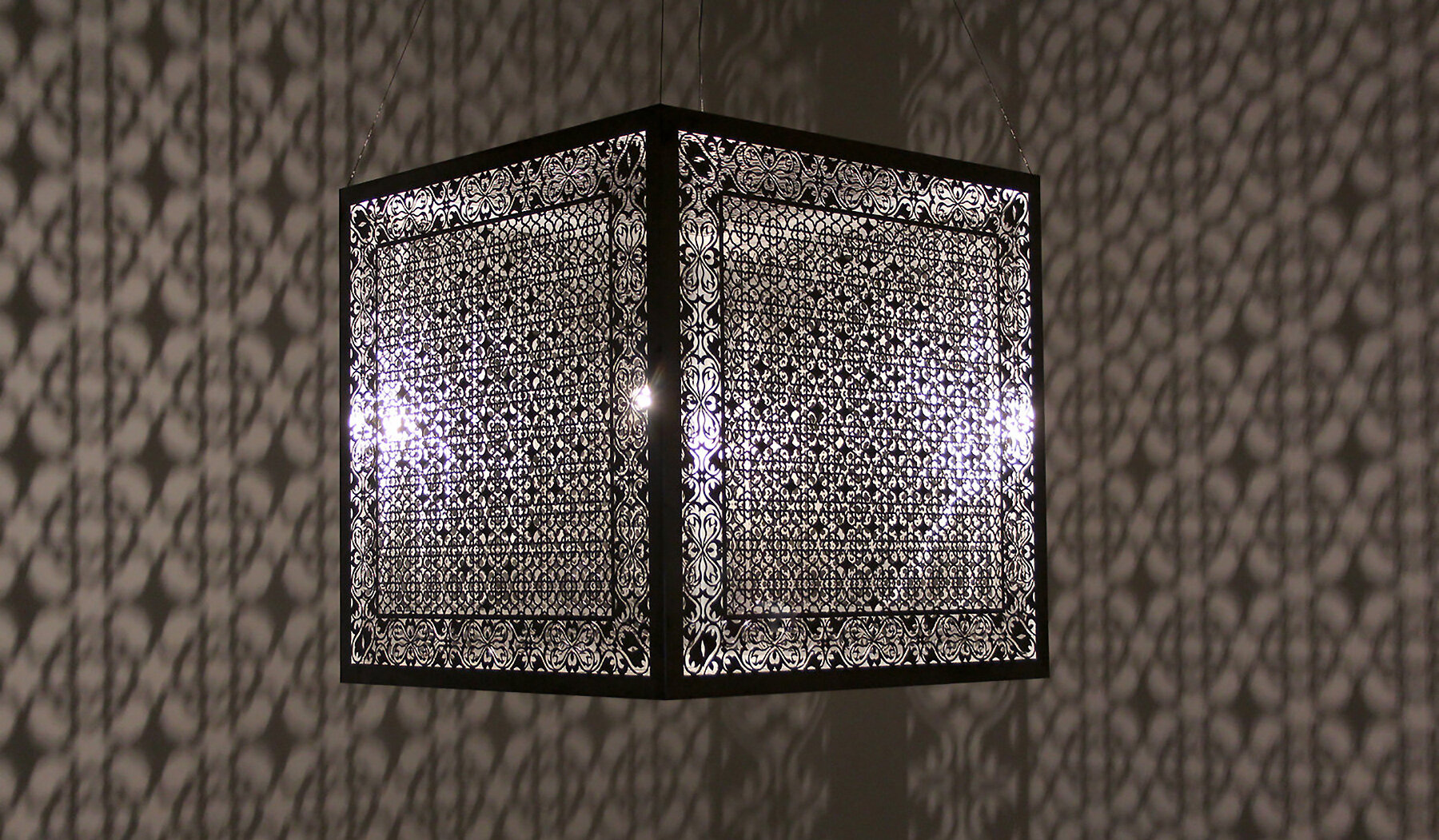
hidden diamond (detail), 2016 lacquered steel and halogen bulb | 36″ x 36″ x 36″
AQA: the year (2020) spent in isolation has, I think, made me and the rest of the world realize the immense value of human interactions and a close-knit community. I don’t want to spend the rest of my life in a virtual environment without close contact or intimate experiences with people, nature or objects. particular locations, places and objects trigger precious memories which are often closely linked to images, sounds and smells. going forward, a combination of virtual and physical environments creating interactive experiences will be key for me. I do think I’m an object maker working in tandem with technology and that will probably not change. and in my opinion, technology will definitely have a far-reaching impact on both contemporary artists and the artwork they may or will produce.
as an aside, I must say that I have read and personally believe that people who enjoy creative pursuits and practice handiwork or craft skills through the utilization of their hands sustain more rewarding lives. however, evaluating the statistical efficacy of artistic or creative pursuits on our societies, such as artmaking, creative-writing, theatrical performances, music and dance is difficult as the resultant renaissance takes time; thus, the progressively lowered governmental and private funding for arts and humanities’ education which ultimately impacts support for creative professionals too. conversely, I believe the entire world largely survived the pandemic isolation of last year due to the creative arts/ crafts such as books, movies, interior design and construction projects, gardening and traditional crafts.
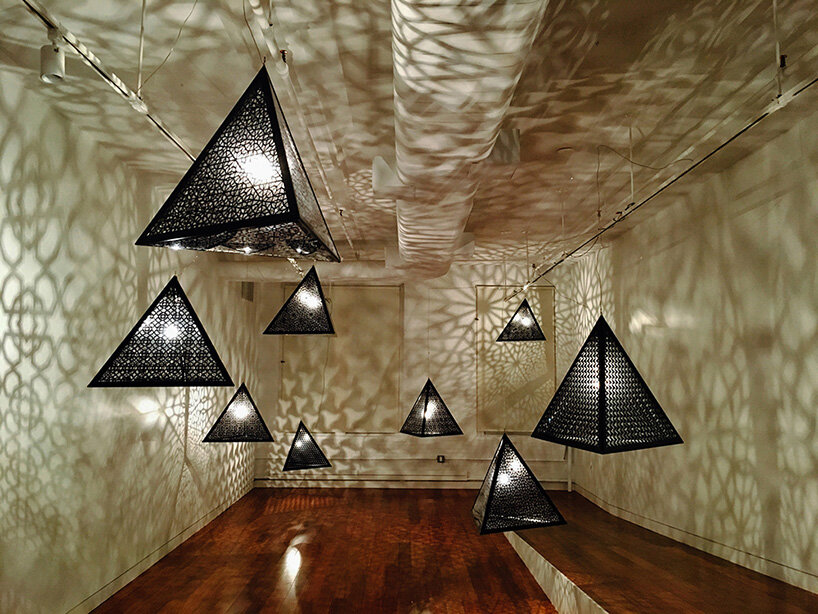
alhambra nights, 2016 | acrylic and halogen bulb | 30″ x 27″ x 30″
AQA (continued): the world population faced immense challenges in the past 1½ years. to me it is obvious that climate change is impacting every living being on this planet, and we are seeing an increase in the frequency of floods, forest fires, tsunamis, tornadoes impacting the ozone layer and warming the planet. the realization of the deep connections between humans and the earth/ nature is timely, so all of us can do our part in preserving the earth for our future generations. I felt deep despair over the loss of human lives and species extinct or close to extinction, and especially the loss of community. yet, I also feel a sense of hope, with the knowledge that when the world came to a standstill, the earth started regenerating and thriving. I do wonder though if our society will revert back to capitalistic consumption at break neck speed like before, once the pandemic isolation is over. so too, I wonder if people will remember the lessons learned during the last year and gravitate towards more hands-on, interactive pursuits and environments instead of gravitating to computer screens/ consumption. I for one am pretty sure the direction I’ll choose, and look forward to continuing a progressively consistent development of my art practice with a hands-on approach.
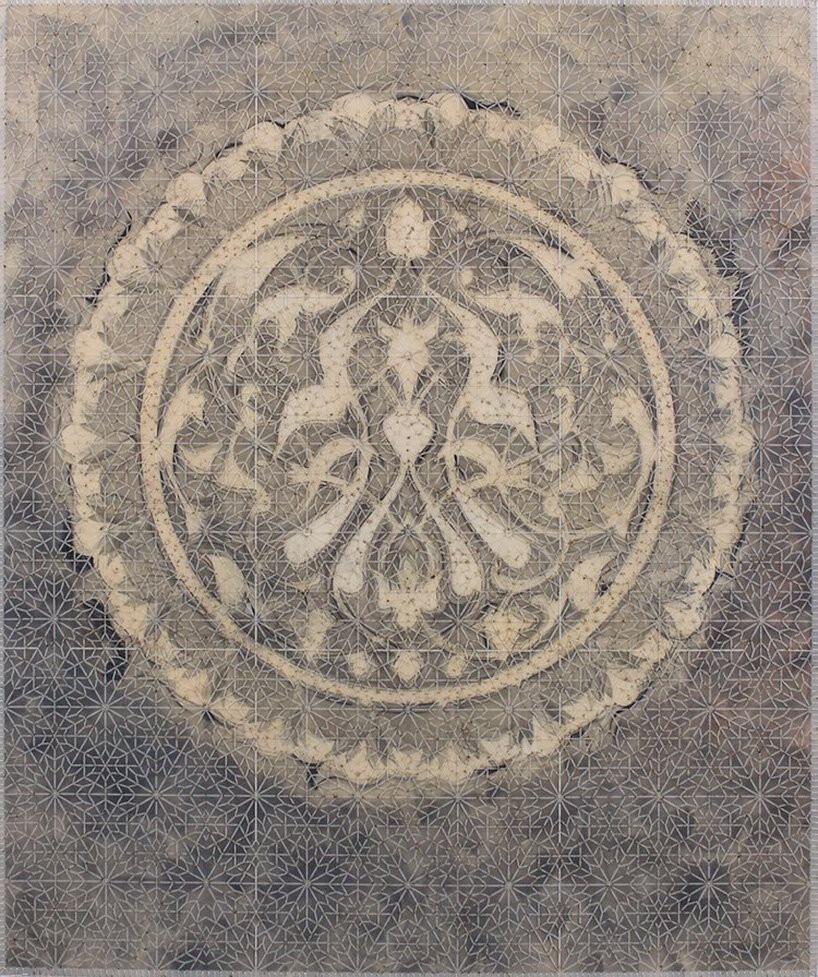
crushed tulips | mixed media on paper (steel dust, pastels, charcoal, wax, beads, embroidery, cut mylar) | 41” x 35.5”
DB: what impressions do you hope your work conjures? what discussions do you hope it provokes?
AQA: my goal, as with all my work, is to invite the viewer to confront the contradictory nature of all intersections while simultaneously exploring boundaries. my drawings and the installations use light, and variation of pattern along with the palpability of reflection, questioning the assumptions of geometric design as a form opposite to representational art. I think the source of this question also lies at the crux of islamic art, which used the geometric form as an example of the pure and transcendent, as opposed to the organic and human. the clean and definite lines and their avowed distance from figurative nature of the lived experience aimed literally to direct spiritual consciousness away from the ambiguity and corruption of the lived form into the certitude of purity. in exploring the interpretive capacities of the geometric motif, I question this dichotomy that lies at the center of islamic art and its departure from the human form. in exploring the varieties of interpretation created by the variations of a motif or pattern, I show the interplay of nature and its collective impact on those that perceive it. in this way I try to question the premise at the heart of islamic art that the certainty of geometry and non-figurative design, like the certainty of religious text and edict, is vulnerable or open to myriad interpretations just like life itself.
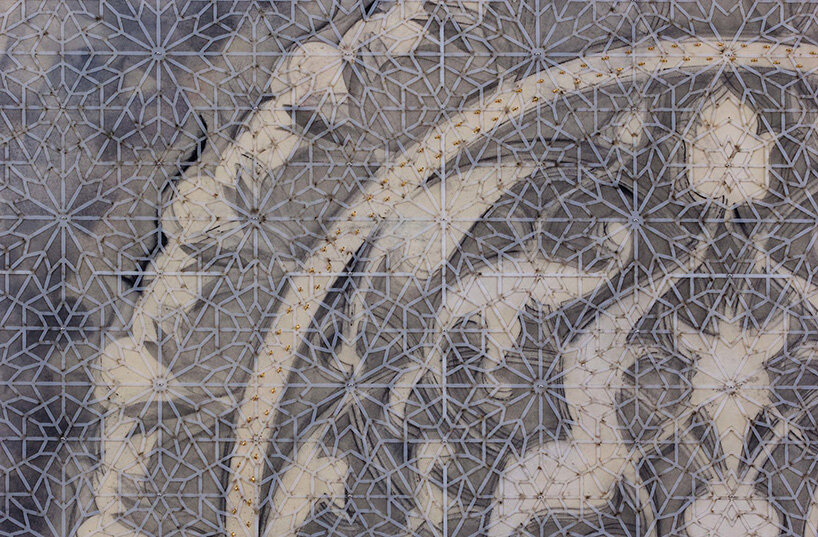
crushed tulips (detail)
AQA (continued): in my design process, I rely on the purity and inner symmetry of geometric design and the interpretation of the cast shadows within the structured objects. I create patterns with porous boundaries between sections like the center vs. the borders. when viewed carefully, hidden shapes or patterns emerge, as surprise elements. depending on the spaces the installation pieces are installed within, the resultant shadows may be direct reflections in tandem with exaggerated or fractured shadows. it’s my way to aid the audience in contemplation of complex ideas that undergird gender roles and shifting identities; social codes, literacy, permeable cultures and unnecessary class systems. usually, I employ light to accentuate and explore the softness within the hardness by creating duality of light/shadow, public/private, and static/dynamic to navigate personal, communal or public space. in my mind this methodology may encourage contemplation of the contradictions faced in metaphorically crossing boundaries between cultures or concepts globally.
additionally, I want my work to provoke an investigation into questions of authenticity, which are central to the post-colonial condition. the intertwining of light and shadow, original and derivative, are at the core of the various renditions of the pattern. they mirror the post-colonial quest for originality and purity and ultimately circular geometric pursuit where primary form can only be imagined and never really captured. in a contextual milieu where difference and divergence dominate most conversations about the intersection of civilization, my artwork explores the presence of harmonies that do not ignore the shadows, ambiguities and dark spaces between them but rather explore them in novel and unexpected ways.
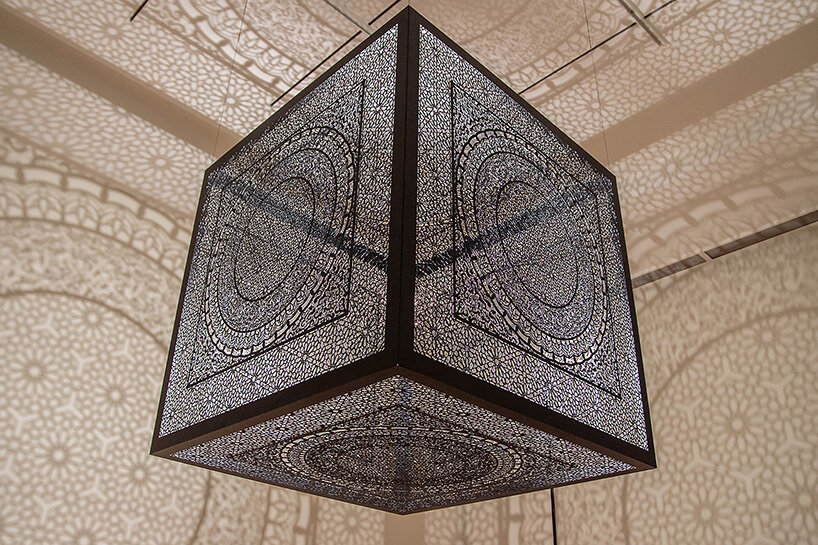
crossing boundaries – black, 2017 | asia society: new york, NY, 2017
lacquered steel and halogen bulb | 48″ x 48″ x 48″
DB: what are you currently fascinated by, and how is it feeding into your artistic practice?
AQA: creating abstract artwork requires ingenuity to reveal concerns and connections to world events. as an artist, I can’t and won’t work in isolation, but need to participate contemporaneously to make sense of history in the making. layered, complex ideas in experiential form that touch upon contradictions of our lived experiences can provide enduring influence on the artist and audience. for me experiences that have had a lasting influence on my own psyche impels me to use similar methodologies to create connections, meaning and enrichment for my audience.
I’m thrilled that racial/gender equity an justice are fully in focus in our global discourse creating positive change. excellent diverse hires, while removing bad players who have harassed and discriminated both gendered and racial minorities in the workplace is a good direction. art museums are finally revising their permanent collections to rectify skewed representation of populations by increasing acquisitions by women, LGBTQR and artists of color. I’m looking forward to future art museum visits that may not feel completely imperial or colonialized and instead I may feel a sense of belonging and representation. the tide has slowly shifted to accommodate concepts that were previously eschewed by the artworld. I’m gladly reading books written by women writers on both female and racially diverse or gendered artists. covering topics that had limited traction in our global discourse mostly effecting women and minorities, like incorporation of crafts or connecting spirituality with beauty previously deemed unviable or banal may now be de rigueur. representation of diverse global artists coupled with under-represented art scholarship is broadening the field by bringing a confluence of ideas that are more expansive and inclusive, thus expanding artmaking. it’s all change for good!
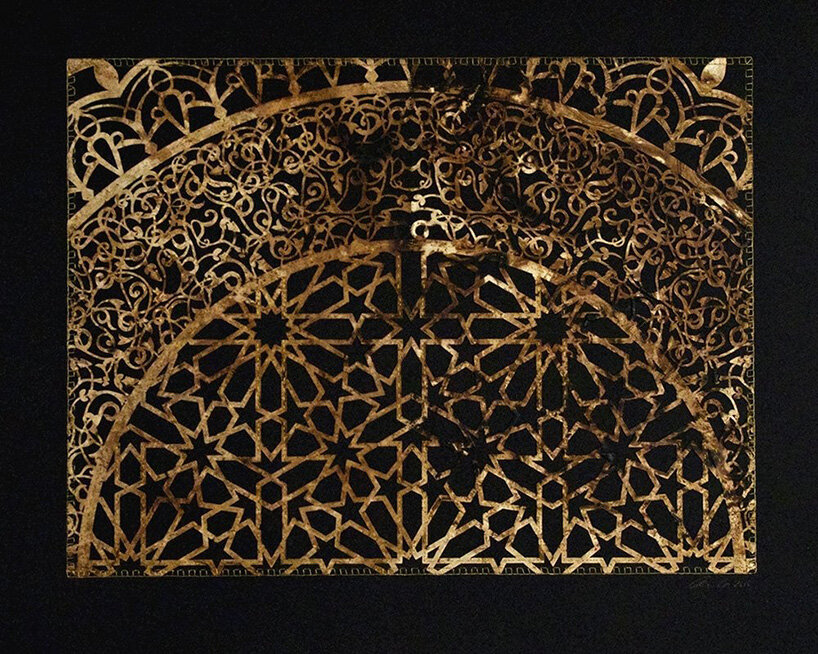
intersections – black 2, 2015 | mixed media on paper | 27.25″ x 33.25″
AQA (continued): additionally, the isolation in the past 14 months has been a time of severe loss. but a silver lining to the loss and isolation was that we all slowed down, which allowed the earth to rejuvenate itself. I hope that humanity has realized the depth of our connection to the earth, and that every action has a reaction that impacts the viability of the planet for us, our future generations, and every other living being sharing the planet. I am excited to read about bumble bees coming back, and seeing bird populations increasing. I hope people in the USA will consider growing bee gardens rather than the manicured lawns that have limited benefits for the planet. hopefully the planet’s long shut-down has slowed the earth’s warming, allowing it to breathe and recuperate from human consumption. and my deepest hope is that the global population will receive COVID vaccinations irrespective of borders, locations, race or color and the rich countries will help the poor so we can eradicate the virus which has played such havoc across porous borders. lastly, I’m excited to start participating within my core and extended communities again that include family members, friends and acquaintances around the world. coming out of this pandemic with renewed vigor to protect the planet and all its inhabitants as gentle/generous guardians will be a great outcome. I think, within my own practice, I’ll start seeing the influence of the past two years which makes me excited. I think change, big or small is good for all of us.
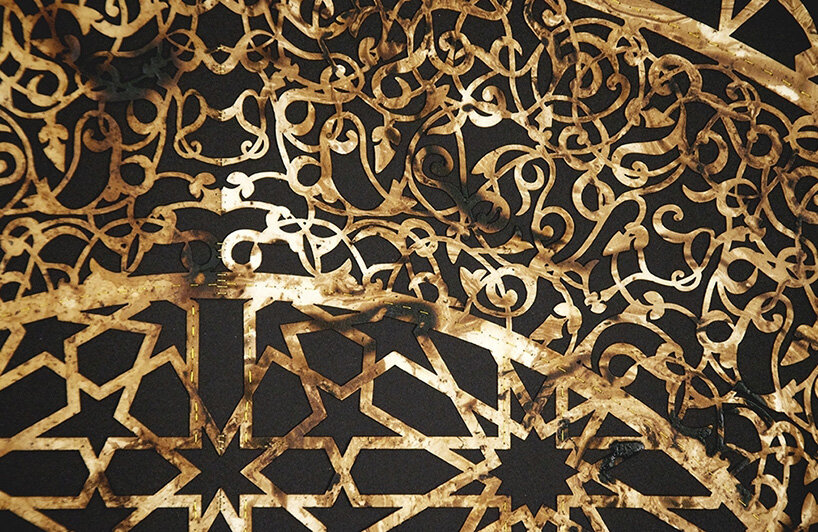
intersections – black 2 (detail)
DB: can you tell us about any upcoming projects you are particularly excited about?
AQA: it has still been a busy year even with the isolation and post-ponements for my exhibitions due to the COVID-19 pandemic in 2020. most of last year, I worked on the artwork for my exhibition titled a beautiful despair, opening in late september 2021 at the amon carter museum of american art in fort worth, texas. I am pleased with the finished artwork, which greatly benefited from virtual visits with various curators nationally, especially shirley reece-hughes of the carter. attending virtual conferences, lectures, artist/curator talks, listening to podcasts, and having time to read was both educational and inspirational, and a real bonus. my second show, re-scheduled from april 2020 to october 2021, titled weight of black will open in october, at the jule colins smith museum of art at auburn university in alabama.
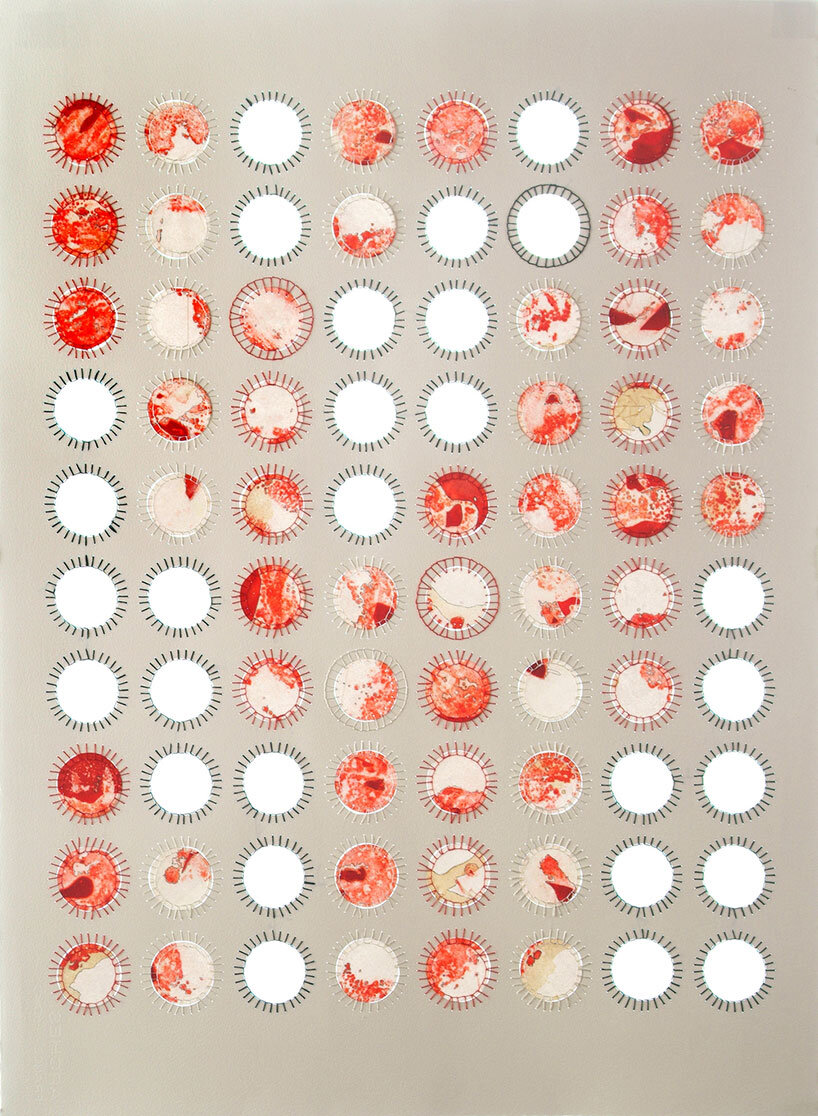
illuminated inner spaces 4, 2005 | mixed media on paper | 30″ x 22″
AQA (continued): another big change last year was my move to augusta, georgia (turning the state blue☺ – kidding) as a professor and resident research scholar at augusta university. my extreme isolation in a brand-new city with no relationships with my new colleagues deepened my already profound sense of loss and sorrow and heightened further, with daily news of the continued loss of lives across the world. the intensity of last year coupled with the change and introduction of new locale, landscape, flora and fauna added depth to my ideas. my previous concerns regarding gender and social/ political issues of discrimination are now encompassed by the extremes of climate change which will largely affect black/brown populations in third world countries. I’m interested in the new possibilities, although it will take time to synthesize the influences and effects of the pandemic on my creative output.

illuminated inner spaces 4 (detail), 2005
AQA (continued): lastly, starting this january 2021, I have been fully focused in designing my first solo exhibition at sundaram tagore gallery in chelsea, new york. the opening is in march 2022, for which I am planning three new immersive installations, a 12’ large wall relief project and multiple embroidered drawings. the gallery is moving to larger premises which I have not physically seen, but viewed through photos and architectural plan drawings. now that the vaccinations are making it possible to travel again, I plan to visit NYC to both check out the new gallery site to ensure my plans for the show are valid, and also visit myriad art museums. for me and most artists I know, showing in NYC is nerve racking and exhilarating and I’m looking forward to it with great anticipation.
thank you, both to you and your audience for the interest in my artwork.
happening this week! holcim, global leader in innovative and sustainable building solutions, enables greener cities, smarter infrastructure and improving living standards around the world.
anila quayyum agha (3)
art interviews (158)
sculpture (395)
PRODUCT LIBRARY
a diverse digital database that acts as a valuable guide in gaining insight and information about a product directly from the manufacturer, and serves as a rich reference point in developing a project or scheme.



